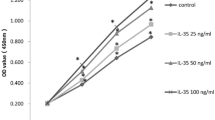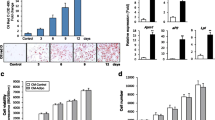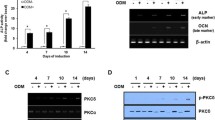Summary
We aimed to examine the effect of pioglitazone on transdifferentiation of preosteoblasts from rat bone marrow mesenchymal stem cells (BMSCs) into adipocytes and investigate its effect on bone metabolism. BMSCs were harvested from the femurs and tibias of a rat, then separated, purified, proliferated for 3 generations and differentiated into preosteoblasts for 5 days and 14 days respectively in the presence of osteogenic medium. Thereafter, the preosteoblasts were cultured for 21 days in the presence of adipogenic medium with and without pioglitazone (1 μg/mL). Partially-differentiated osteoblasts were identified by mineralized nodules with Alizarin red S staining. Transdifferentiated adipocytes were identified by Oil Red O staining. Reverse transcription PCR (RT-PCR) was performed to assay the expression levels of osteogenic markers Runx2 and ALP, and an adipogenic marker PPARγ. Those cells cultured for 5 days did not show mineralized nodules as detected by staining of Alizarin red S, while those cultured for 14 days showed dispersed mineralized centers in the form of brown spots, although without obvious red mineralized nodules. After adipogenic transdifferentiation for 21 days, adipose-drops were found in cells of 5CG and 5EG earlier than those of 14CG and 14EG, and the former showed much more adipocytes separately as detected by Oil Red O staining. Whatever the time was 5 days or 14 days of BMSCs osteogenic differentiation, the cells cultured with pioglitazone showed much more adipocytes than those without pioglitazone. Our experiment showed that the less time it took for BMSCs osteogenic differentiation, a stronger ability remained for BMSCs to transdifferentiate into adipocytes. The mRNA expression levels of Runx2 and ALP were decreased by 1.79 and 1.90 times respectively in 5EG (P< 0.05) as compared with 5CG, and that of PPARγ was increased by 1.31 times in 5EG (P<0.05) as compared with 5CG. The mRNA expression levels of Runx2 and ALP were decreased by 1.45 and 1.54 times respectively in 14EG (P<0.05) as compared with 14CG, and that of PPARγ was increased by 1.39 times in 14EG (P<0.05) as compared with 14CG. It was concluded that pioglitazone stimulated the transdifferentiation of BMSCs into adipocytes. These observations provided a potential mechanism of imbalance in thiazolidinedione induced bone metabolism.
Similar content being viewed by others
References
Schwartz AV, Sellmeyer DE, Vittinghoff E, et al. Thiazolidinedione (TZD) use and bone loss in older diabetic adults. J Clin Endocrinol Metab, 2006,91(9):3349–3354
Goldstein BJ. Clinical translation of “a diabetes outcome procession trial”: ADOPT appropriate combination oral therapies in type 2 diabetes. J Clin Endocrinol Metab, 2007,92(4):1226–1228
Yaturu S, Bryant B, Jain SK. Thiazolidinedione treatment decreases bone mineral density in type 2 diabetic men. Diabetes Care, 2007,30(6):1574–1576
Schilling T, Nöth U, Klein-Hitpass L, et al. Plasticity in adipogenesis and osteogenesis of human mesenchymal stem cells. Mol Cell Endocrinol, 2007,271(1–2):1–17
Ali AA, Weinstein RS, Stewart SA, et al. Rosiglitazone causes bone loss in mice by suppressing osteoblast differentiation and bone formation. Endocrinology, 2005, 146(3):1226–1235
Pfaffl MW, Horgan GW, Dempfle L. Relative expression software tool (REST) for group-wise comparison and statistical analysis of relative expression results in real-time PCR. Nucleic Acids Res, 2002,30(9):e36
Rzonca SO, Suva LJ, Gaddy D, et al. Bone is a target for the antidiabetic compound rosiglitazone. Endocrinology, 2004,145(1):401–406
Sorocéanu MA, Miao D, Bai XY, et al. Rosiglitazone impacts negatively on bone by promoting osteoblast/ost-eocyte apoptosis. J Endocrinol, 2004,183(1):203–216
Benvenuti S, Cellai I, Luciani P, et al. Rosiglitazone stimulates adipogenesis and decreases osteoblastogenesis in human mesenchymal stem cells. J Endocrinol Invest, 2007,30(9):26–30
Moerman EJ, Teng K, Lipschitz DA, et al. Aging activates adipogenic and suppresses osteogenic programs in mesenchymal marrow stroma/stem cells: the role of PPAR-γ2 transcription factor and TGF-β/BMP signaling pathways. Aging Cell, 2004,3(6):379–389
Lin TH, Yang RS, Tang CH, et al. PPARgamma inhibits osteogenesis via the down-regulation of the expression of COX-2 and iNOS in rats. Bone, 2007,41(4):562–574
Author information
Authors and Affiliations
Corresponding author
Additional information
This project was supported by the Doctoral Fund of Ministry of Education of China (No. 200804871155).
Rights and permissions
About this article
Cite this article
Wang, L., Li, L., Gao, H. et al. Effect of pioglitazone on transdifferentiation of preosteoblasts from rat bone mesenchymal stem cells into adipocytes. J. Huazhong Univ. Sci. Technol. [Med. Sci.] 32, 530–533 (2012). https://doi.org/10.1007/s11596-012-0091-x
Received:
Published:
Issue Date:
DOI: https://doi.org/10.1007/s11596-012-0091-x




